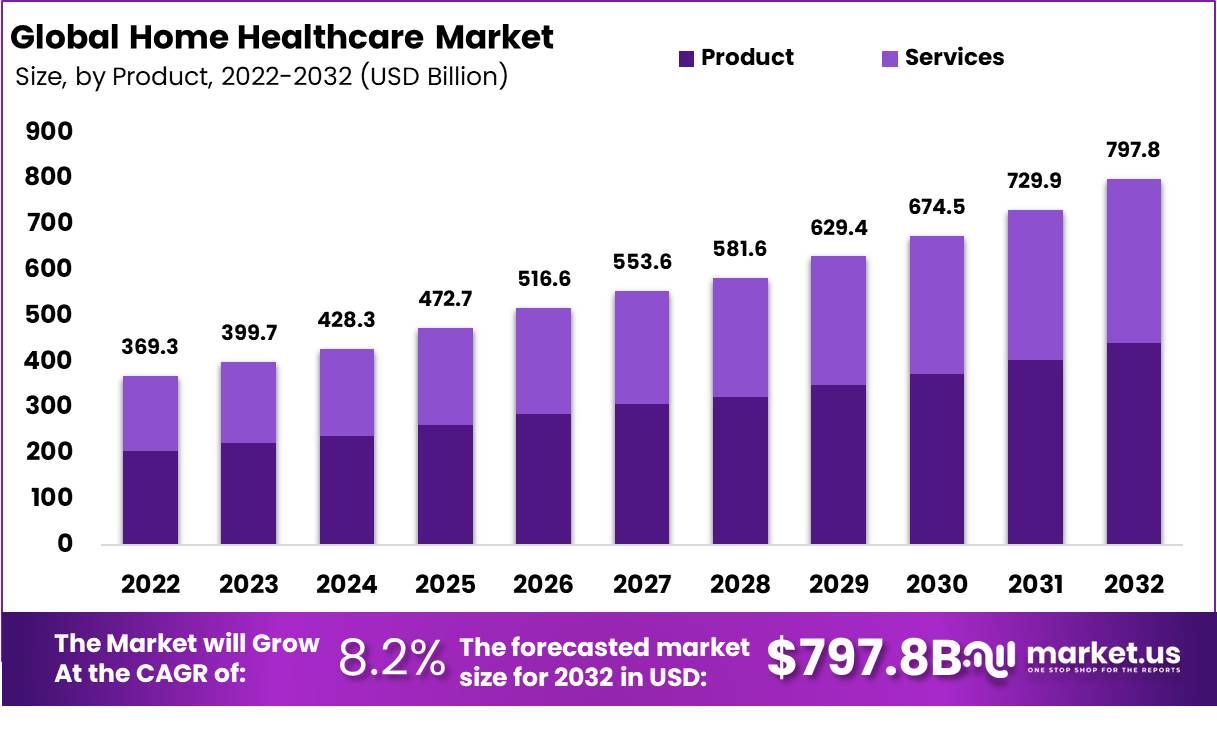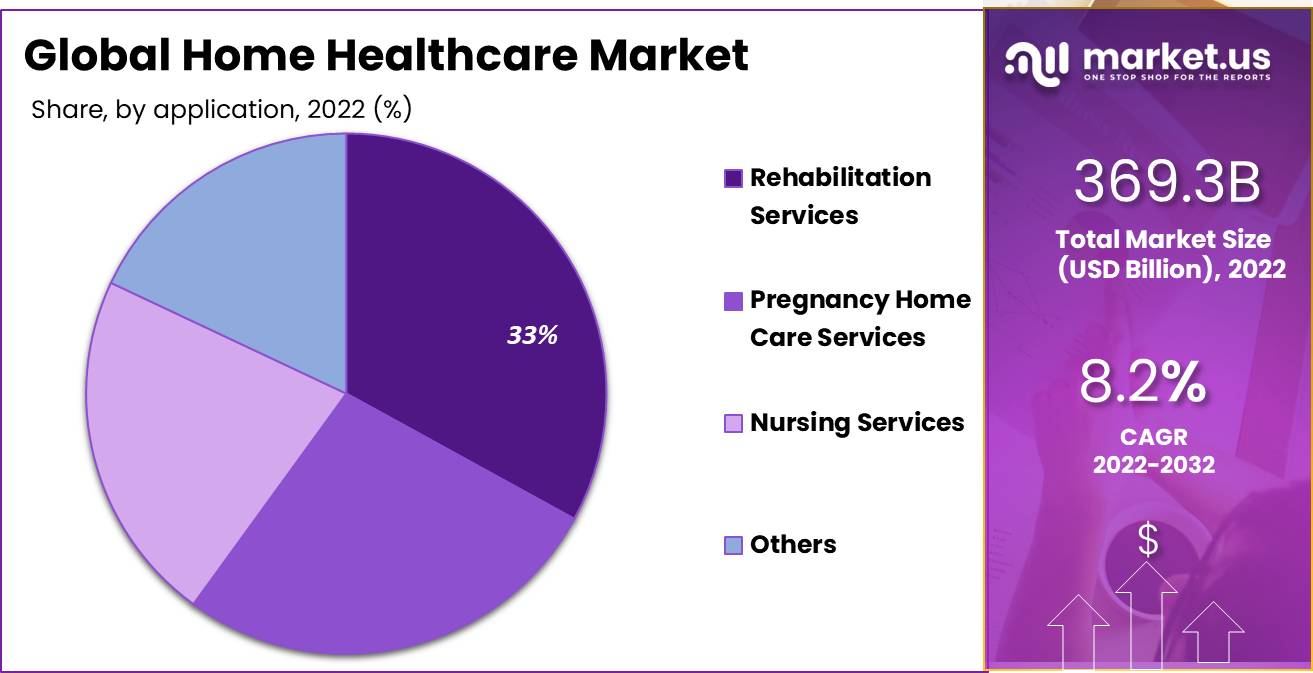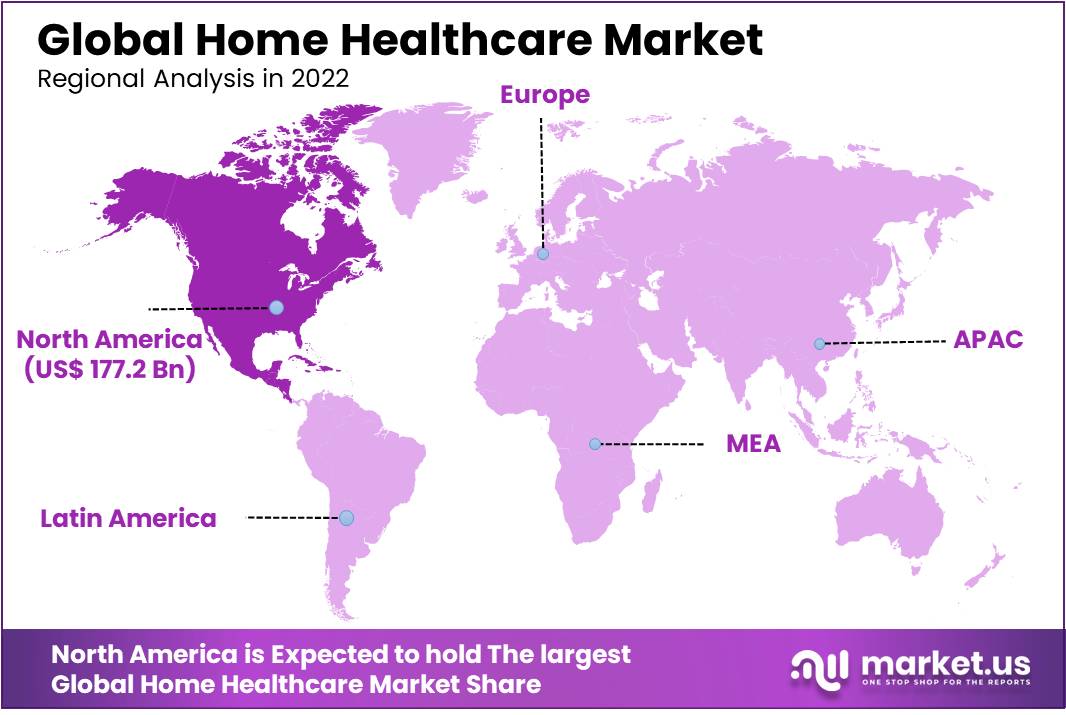Global Home Healthcare Market By Equipment (Therapeutic, Diagnostic, and Mobility Assist), By Services (Skilled Home Healthcare Services and Unskilled Home Healthcare Services), By Region and Companies - Industry Segment Outlook, Market Assessment, Competition Scenario, Trends and Forecast 2023-2032
- Published date: Oct 2023
- Report ID: 64786
- Number of Pages: 233
- Format:
- keyboard_arrow_up
Quick Navigation
Report Overview
The Home Healthcare Market size is expected to be worth around USD 797.8 billion by 2032 from USD 369.3 billion in 2022, growing at a CAGR of 8.2% during the forecast period from 2023 to 2032.
Home healthcare is a term that refers to medical services that are provided at the patient’s home. There are many options available to patients for home healthcare services. Patients can receive nursing care or specialized medical treatment, depending on their individual circumstances. The doctor will determine the treatment plan and any home treatments the patient may need. The length of home healthcare may vary depending on the patient’s health.

Key Takeaways
- The Home Healthcare Market is expected to reach USD 797.8 billion by 2032.
- This Home Healthcare Market is projected to have a Compound Annual Growth Rate of 8.2%.
- Therapeutic products had the highest market share among product categories in 2022.
- Skilled nursing services are expected to grow the fastest among services during the forecast period 2023-2032.
- North America dominated the market in 2022, with a 40% revenue share.
- Asia Pacific held a 23% revenue share in 2022.
- Europe is projected to grow at the fastest CAGR from 2023-2032.
- Home healthcare services cost around USD 50 per day, compared to USD 3,300 per day for hospital care.
- The global aging population and the rising number of chronic diseases are driving the demand for home healthcare services.
By Product Analysis
The Therapeutic Products Segment Accounted for the Highest Market Share.
The global home healthcare market is segmented on the basis of products such as therapeutic products, testing, screening & monitoring products, mobility care products, and others. In 2022, the medicinal products segment accounted for the highest share. This is mainly due to rising rates of chronic illnesses such as sleep disorders, respiratory disorders, and kidney disease, which has led to an increase in demand for therapeutic product value for the home healthcare market. The high prices of hospital beds and related hospital services have changed the mindsets of patients getting comfortable and cost-effective home services. There is a high demand for healthcare services and products such as ventilators, continuous positive airway pressure (CPAP) devices, nebulizers, and other related services.
These devices are mainly used by patients to cure, diagnose, and analyze various respiratory-related diseases in their own homes. The affecting factors such as growing awareness of the acceptance of home healthcare services in developing regions, rapid adoption of advanced technology in home-based healthcare services, and increasing the number of old age people population suffering from different health-related diseases such as Alzheimer’s and Dementia, causing a high opportunity for the key players. The rising count of other chronic diseases and the growing rate of new regulations regarding the home health market globally are also raising the value of home healthcare services.
By Services Analysis
The Segment of Skilled Nursing Services is Expected to Grow the Fastest During the Forecast Period 2023-2032
By Service analysis, the global home healthcare market is segmented into Rehabilitation services, Pregnancy home care services, Skilled nursing services, and Others. The segment of Skilled Nursing Services is expected to grow the fastest during the forecast period 2023-2032. This segment’s growth is due to an increasing need for skilled nursing services and the rising prevalence of chronic illnesses. The upcoming growth opportunities for the home healthcare market in capable segment nursing contain different types, such as telehealth Services which mainly use for remote monitoring and other communication technologies to increase’s care coordination, number of patient attachments, and remote area health monitoring.
The second most famous factor is artificial Intelligence (AI) algorithms used to gain personalized patient care plans and daily medication reminders, as well as to automatically operate clinical tasks. The wearable devices help to monitor patients and provide data to healthcare coordinators. The focus factor is automated care systems which are mainly used to analyze and offer different treatments to patients in their own homes. At last, the factor is cloud-based solutions which can help to organize communication and balance between physicians and patients, as well as maintain the storage and privacy of patient data.

Key Market Segments
By Product
- Therapeutic Products
- Testing, Screening & Monitoring Products
- Mobility Care Products
- Others
By Services
- Rehabilitation services
- Pregnancy home care services
- Skilled Nursing services
- Others
Drivers
Home Healthcare is essential due to the rising aging population and nuclear homes.
Nearly every country on the planet is experiencing an increase in older people and their proportion in their populations. The world’s population of 65 years and older reached 703 million in 2019. The number of seniors is expected to rise to 1.5 billion by 2050. All countries are expected to see an increase in the life expectancy of 65-year-olds between the forecast period 2023 and 2032. While women currently live longer than men by 4.8 years, this gap is expected to shrink over the next three decades. According to both economic and demographic data, the rate of population aging seems to depend on how old people are in terms of their consumption and output.
Rising healthcare costs drive demand for affordable home care
The complexity of healthcare procedures, multiple diseases in patients, changing government policies, and high insurance premiums are all contributing to rising healthcare costs. In the US, for example, healthcare costs have increased dramatically over the past few decades. Healthcare becomes costlier as the population ages and lives longer. Half of the increase in healthcare spending was due to rising healthcare costs, especially inpatient hospital care. These two factors are also crucial in driving such spending up (12%), along with population growth (23%) or population aging. For example, Medicare and Medicaid have seen an increase in total demand for medical services. The rise in medical costs has been directly linked to an increase in chronic diseases such as heart disease and diabetes, especially among seniors.
Restraints
Lack of insurance coverage
Home healthcare services are covered mainly by insurance companies, but this insurance coverage is only carried to organizations that are Medicare-certified organizations. The Insurance does not pay if any equipment is used for distance monitoring, multi-parameter monitoring, rehabilitation, or telemetry. Insurance money for this equipment is not applicable in North American nations as well as in Europe. For the elderly and chronic illnesses, treatments are not repaid by insurance companies in Asian countries, and they are only covered if patients have post-hospitalization therapies.
Opportunity
Rising market value for telehealth
The rising adoption of telehealth providing services in the global home healthcare market is creating a significant opportunity for global healthcare providers and vendors. Home healthcare providers can still have a vision even when they are not physically active at the location, but with the help of telehealth, it is possible to analyze or monitor a patient continuously and reduce future events before they happen. Remote patient monitoring, educational services, and virtual medicine are all in the sector of telehealth. With the help of audio-visual technologies, nurses or doctors during virtual sessions monitor a patient’s overall condition and give the best course of action, which may conclude by providing care with a written prescription or, in some other situations, sending the patient for get additional treatment.
Regional Analysis
North America Dominates the Global Home Healthcare Market During the Forecast Period
The largest share held by the North American region in the global market is anticipated to the rising incidence of complex ailments and its advanced healthcare infrastructure. The report provides a comprehensive analysis of the U.S. home healthcare market, highlighting its growth potential and key trends.
Additionally, the Asia-Pacific region market is expected to grow at the maximum CAGR during the forecast period (2023-2032). The overall growth in the region of Asia Pacific is due to the high rate of chronic diseases and substantial healthcare costs.

Key Regions
- North America
- The US
- Canada
- Mexico
- Western Europe
- Germany
- France
- The UK
- Spain
- Italy
- Portugal
- Ireland
- Austria
- Switzerland
- Benelux
- Nordic
- Rest of Western Europe
- Eastern Europe
- Russia
- Poland
- The Czech Republic
- Greece
- Rest of Eastern Europe
- APAC
- China
- Japan
- South Korea
- India
- Australia & New Zealand
- Indonesia
- Malaysia
- Philippines
- Singapore
- Thailand
- Vietnam
- Rest of APAC
- Latin America
- Brazil
- Colombia
- Chile
- Argentina
- Costa Rica
- Rest of Latin America
- Middle East & Africa
- Algeria
- Egypt
- Israel
- Kuwait
- Nigeria
- Saudi Arabia
- South Africa
- Turkey
- United Arab Emirates
- Rest of MEA
Key Players Analysis
The global home healthcare market is moderately handled by the top players such as F. Hoffmann-La Roche, Ltd., Ge Healthcare, Linde plc., Abbott, Fresenius SE & Co. KGaA, and other healthcare services providing enterprises. The majority of the market share in 2021 in the home healthcare market accounted for a high degree of competition among the market players. Only prominent companies can handle a vast considerable capital investment with the high cost of R&D and manufacturing. This will restrain new players from entering this market.
Listed below are some of the most prominent global home healthcare market key players.
Market Key Players
- McKesson Medical-Surgical Inc.
- Acelity L.P.
- 3M Healthcare
- Becton, Dickinson, And Company
- Braun Melsungen AG
- Fresenius Medical Care
- Arkray, Inc.
- Medline Industries, Inc.
- Baxter International Inc.
- Medtronic PLC
- ConvaTec Group PLC
- Molnlycke Health Care
- Hollister Inc.
- Others
Recent Developments
- ResMed, a San Diego-based company, announced in March 2019 that it had acquired HB Healthcare. This acquisition will allow ResMed to expand its reach in Asia Pacific.
- Tandem Diabetes Care was approved by the U.S. Food and Drug Administration for its t: SlimX2 insulin pump. It can be used both in children and adults with type 1 diabetes.
- Apple Watch 4 was launched in September 2018 as an FDA Class 2 medical device.
- The U.S. Food and Drug Administration published a March 2019 letter regarding cybersecurity vulnerabilities in Medtronic’s cardiac implantable cardioverter-defibrillators.
Report Scope
Report Features Description Market Value (2022) USD 369.3 Bn Forecast Revenue (2032) USD 797.8 Bn CAGR (2023-2032) 8.2% Base Year for Estimation 2022 Historic Period 2016-2022 Forecast Period 2023-2032 Report Coverage Revenue Forecast, Market Dynamics, COVID-19 Impact, Competitive Landscape, Recent Developments Segments Covered By Product (Therapeutic Products, Testing Screening & Monitoring Products, Mobility Care Products, and Others ); By Services (Rehabilitation Services, Pregnancy Home care services, Skilled Nursing services, Others) Regional Analysis North America – The US, Canada, & Mexico; Western Europe – Germany, France, The UK, Spain, Italy, Portugal, Ireland, Austria, Switzerland, Benelux, Nordic, & Rest of Western Europe; Eastern Europe – Russia, Poland, The Czech Republic, Greece, & Rest of Eastern Europe; APAC – China, Japan, South Korea, India, Australia & New Zealand, Indonesia, Malaysia, Philippines, Singapore, Thailand, Vietnam, & Rest of APAC; Latin America – Brazil, Colombia, Chile, Argentina, Costa Rica, & Rest of Latin America; The Middle East & Africa – Algeria, Egypt, Israel, Kuwait, Nigeria, Saudi Arabia, South Africa, Turkey, United Arab Emirates, & Rest of MEA. Competitive Landscape McKesson Medical-Surgical Inc., Acelity L.P., 3M Healthcare, Becton, Dickinson And Company, Braun Melsungen AG, Fresenius Medical Care, Arkray, Inc., Medline Industries, Inc., Baxter International Inc., Medtronic PLC, ConvaTec Group PLC, Molnlycke Health Care, Hollister Inc., Others Customization Scope Customization for segments, region/country-level will be provided. Moreover, additional customization can be done based on the requirements. Purchase Options We have three licenses to opt for Single User License, Multi-User License (Up to 5 Users), Corporate Use License (Unlimited User and Printable PDF) 
- McKesson Medical-Surgical Inc.
- Acelity L.P.
- 3M Healthcare
- Becton, Dickinson and Company Profile
- B. Braun Melsungen AG Company Profile
- Fresenius Medical Care
- Arkray, Inc.
- Medline Industries, Inc.
- Baxter International Inc.
- Medtronic PLC
- ConvaTec Group PLC
- Molnlycke Health Care
- Hollister Inc.
- Others
- settingsSettings
Our Clients
| Single User $4,599 $3,499 USD / per unit save 24% | Multi User $5,999 $4,299 USD / per unit save 28% | Corporate User $7,299 $4,999 USD / per unit save 32% | |
|---|---|---|---|
| e-Access | |||
| Report Library Access | |||
| Data Set (Excel) | |||
| Company Profile Library Access | |||
| Interactive Dashboard | |||
| Free Custumization | No | up to 10 hrs work | up to 30 hrs work |
| Accessibility | 1 User | 2-5 User | Unlimited |
| Analyst Support | up to 20 hrs | up to 40 hrs | up to 50 hrs |
| Benefit | Up to 20% off on next purchase | Up to 25% off on next purchase | Up to 30% off on next purchase |
| Buy Now ($ 3,499) | Buy Now ($ 4,299) | Buy Now ($ 4,999) |












